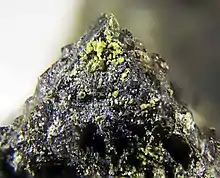Mathesiusite
Mathesiusite is a sulfate mineral containing potassium, vanadium, and uranium and has the chemical formula: K5(UO2)4(SO4)4(VO5)·4(H2O). It is a secondary mineral formed during post-mining processes.
| Mathesiusite | |
|---|---|
 Yellow microcrystals of the extremely rare uranium mineral mathesiusite (IMA 2013-046) from one of the only two known localities worldwide: North Mesa Mine group, Temple Mountain, Emery County, Utah, United States of America. | |
| General | |
| Category | Sulfate mineral |
| Formula (repeating unit) | K5(UO2)4(SO4)4(VO5)·4(H2O) |
| Strunz classification | 7.DG. |
| Crystal system | Tetragonal |
| Crystal class | P4/n |
| Identification | |
| Color | Yellowish green |
| Crystal habit | Needles <0.2 mm in length |
| Cleavage | Perfect {010}, good {001} |
| Fracture | Irregular/Uneven |
| Tenacity | Brittle |
| Mohs scale hardness | 2 |
| Streak | Greenish white |
| Specific gravity | 4.02 (calculated) |
| Optical properties | Uniaxial (-) |
| Refractive index | nω = 1.634() nε = 1.597(3) |
| Birefringence | δ = 0.037 |
| Other characteristics | |
| References | [1][2] |
It was discovered in the Jáchymov mining district, Czech Republic and named in 2013 after Johannes Mathesius (1504–1565), who studied minerals from the area (known then as Joachimsthal, Bohemia).[3]
References
- Mathesiusite on Mindat.org
- Mathesiusite on Mineralien Atlas
- Plášil, J.; Veselovský, F.; Hloušek, J.; Škoda, R.; Novák, M.; Sejkora, J.; Čejka, J.; Škácha, P.; Kasatkin, A.V (April 1, 2014). "Mathesiusite, K5(UO2)4(SO4)4(VO5)(H2O)4, a new uranyl vanadate-sulfate from Jáchymov, Czech Republic". American Mineralogist. 99 (4): 625–632. doi:10.2138/am.2014.4681. Retrieved 13 June 2017.
This article is issued from Wikipedia. The text is licensed under Creative Commons - Attribution - Sharealike. Additional terms may apply for the media files.